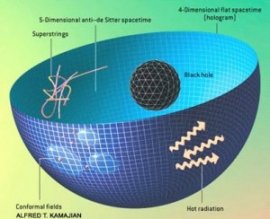
 The job of theoretical physicists is describing the universe – a complex, subtle, and extremely weird place from a human perspective. It seems weird because we occupy a certain range of size and distance, which has adapted our intuition to a very narrow range of reality.
The job of theoretical physicists is describing the universe – a complex, subtle, and extremely weird place from a human perspective. It seems weird because we occupy a certain range of size and distance, which has adapted our intuition to a very narrow range of reality.
It is amazing that we have been able to use our collective intellect to probe the universe at scales of size, distance, and time that are vastly outside our experience. Two tools of intellectual rigor have made this possible – math and science.
Theoretical physicists sometimes rely more on the former than the latter. This means they spend their time constructing mathematical descriptions of the universe based upon what is already known. They are thinking about what might be, and then seeing if they can make the math work out.
Such a process is part of science, but it does not close the loop on science until the mathematical models are tested against reality in some way. This may pose theoretical or practical hurdles.
Einstein’s special an then general relativity lived in a world of theoretical mathematical models until they were tested against reality, then they became science, and Einstein became a rock star.
Today one of the forefronts of theoretical physics is string theory, the notion that at a fundamental level reality can be described as multidimensional tiny vibrating strings. The goal of string theory is to merge general relativity, which described gravity and spacetime, and quantum mechanics, which describes how matter and energy behave at the tiniest scales. We do not currently have a theory of quantum gravity, that accommodates both, and the primary hope for string theory is that it will provide a theory of quantum gravity.
The Holographic Principle
The holographic principle is another product of string theory. The idea was inspired by the theoretical physics of black holes, the remnants of dead giant stars whose gravity is so intense it overcomes all physical restraints and pulls itself into a singularity. Black holes are so dense that near them the gravitation field is so strong light itself cannot escape. The boundary at which light can no longer escape is called the event horizon.
Stephen Hawking and other physicists have been engaged in a many-decade-long debate about the nature of information and entropy in a black hole. Of course, I am massively oversimplifying all of this, and I only understand it at a simplified level. The basic question is this, however – do black holes have entropy.
If they have zero entropy, like a gravitational or magnetic field (because they are completely predictable and not random) then that creates a paradox. If something with entropy falls into a black hole, which has zero entropy, then that entropy has disappeared from the universe, in violation of the second law of thermodynamics.
One solution to this paradox is that black holes do have entropy, in fact they may have the maximal amount of entropy possible. Physicist Jacob Bekenstein calculated what that maximal entropy is and found that it is proportional to the square of the radius of a volume of space, not the cube. Therefore the amount of entropy (one can also think of this as the amount of information) within a black hole’s event horizon is equal to the amount of entropy on its surface – on the area of the event horizon itself.
The holographic principle takes this idea and extrapolates it to the universe itself. Any region of space time that has a boundary, especially a boundary determined by the behavior of light, may have all of its information contained on the surface area of the boundary.
This could mean that the entire 3 dimensional universe can be described by the information on the 2 dimensional boundary of the universe itself – which is sort of analogous to a hologram.
OK, but how do you test it?
The holographic universe is a wild idea, but then again so was relativity and quantum mechanics. The core question is – does the holographic principle represent just a mathematical fantasy, or does it reflect something about the real universe? Science is not content to have elegant systems of explanation that are internally consistent. Science endeavors to understand actual reality.
This means physicists have to figure out some way to test their wacky ideas. Researchers at Fermi National Accelerator Laboratory (Fermilab) think they may have done so. The idea is this – if the holographic principle is real, then perhaps there is also an uncertainty principle with respect to this information as well. This would mean, just like you cannot describe the exact position and momentum of a particle with arbitrary precision, perhaps you cannot describe the exact 3-dimensional coordinates of any place in spacetime. The 2-D holographic information would obey its own uncertainty principle.
RELATED VIDEO











